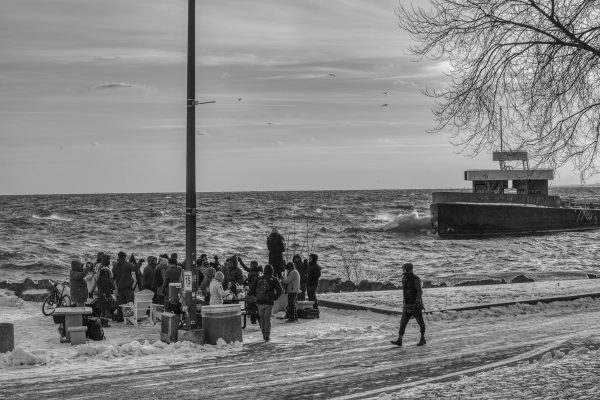With the chaotic Greenbelt scandal swirling in the background, the updated plans for the Ford government’s deeply contentious and destructive scheme for Ontario Place’s West Island are once again being shared with the public during the latest round of consultations held by the City of Toronto’s planning department. The fantastical renderings of this tawdry proposal stand in stark contrast to the glorious images in a new volume of photographs of Ontario Place, by the veteran Toronto photographer Steven Evans (disclosure: I wrote the introduction).
As It Is, a self-published volume, sees Evans explore Ontario Place, and challenges us to not only look beyond Therme’s heavily-hyped plans, but also past the park’s neglected condition — and to embrace its unique sense of place. I spoke last week with Steven about his creative process.
John Lorinc: What was going on when you took this picture [above]?
Steven Evans: The picture was taken February, 2023. I was doing a circuit around the perimeter of the site and started at the West channel breakwater on the west side of West Island, where I was trying to take photographs of the really spectacular waves. The weather was incredible. The waves were huge, and I became so engrossed. It was freezing cold and really windy. In an instant, I was blown off my feet. Just knocked right down, landing in a heap on the icy path below me.
I bruised myself up a bit and became pretty worried about whether my cameras had sustained any damage. I continued on, moving around the perimeter of the island, taking pictures but not absolutely certain that things were going to work out. I had two cameras that day, and also had brought an extra telephoto lens with me, which I don’t usually use.
I walked south and then east along the path past Pebble Beach. The weather started to improve quite dramatically, the clouds broke and the sun came out. The light went from being somewhat dark and flat to bright and contrast-y. With that kind of change in weather, it got even colder and by this time, I wasn’t really into taking photographs and thought I would make my way home via the East Island.
As I arrived at East Island, I heard the sound of really loud music and could see in the distance this crowd of people dancing around a fire pit. There had to have been about 25 people. They were having the time of their life, just jumping around, socializing and trying to keep each other warm. It was a really spectacular thing.
I spoke to one of the organizers to let him know what I was up to and just tried to jump into it. The group was some kind of social club, with people getting together and meeting each other, most of them for the first time. I started taking pictures, but one of my cameras just wasn’t working, so I resorted to climbing up one of Michael Hough’s berms to take pictures of the crowd from a distance, using my telephoto lens, anchoring the shot with the roiling lake behind, the crowd and the Sunken Ship’s breakwater in the distance.
It was a lovely scene because it proved that even the coldest winter conditions are not nearly as forbidding as some people would like us to think. They were having a fabulous time and all it took was a fire pit and the collective desire to be there.
JL: That’s a wonderful story. One of the things that people will appreciate when they start looking through this book, is that you were shooting right around the calendar, right like all seasons, and can you talk a little bit about you know, how you started shooting there, and why you wanted to sort of present Ontario Place as a 12-month, destination or location or place.
SE: When I started doing the Ontario Place photography, I had no intention of turning it into a book. It originally started as a day out with my wife Cynthia and our friend Beth Kapusta to go down and explore the abandoned log flume amusement ride. I ditched those two and made my way into the depths of West Island spending an hour photographing the derelict ride. I hadn’t been to Ontario Place for quite some time. I wasn’t aware at that moment what was really going on [with talk of the redevelopment proposal]. I met back up with Cynthia and Beth and as we made our way out I could see that the entire place was languishing. The Zeidler buildings were rusting, the modular buildings were abandoned and decaying, and the Michael Hough landscaping was degraded and suffering.
I learn from taking pictures, and I went back and started looking into what was going on in Ontario Place and consequently began to accelerate the whole process of taking photographs there. I found the place fascinating in all seasons. It was November, 2021, when I started taking photographs. It didn’t even occur to me that Ontario Place was only meant to be a four- or five-month destination.
I was especially drawn to visit in the winter because the crowds are fewer and I really enjoy the quiet and solitude there. The sounds of the city are muted, apart from the occasional airplane flying overhead. On the other hand, the lake can get pretty temperamental when the winds blow hard and waves crash against the stone-protected shoreline. It’s just a wonderful place to be any time.
JL: One of the things that strikes me about the images in the book is that the lake is a huge character. There’s this edge condition at Ontario Place. Could you talk about that?
SE: In 2017, I was travelling in Newfoundland with Cynthia. It was mid-June, and we were headed to a place called Change Islands, an archipelago on the northwest side near Fogo Island. We arrived at the ferry docks to find an inundation of Arctic ice that had clogged the shores and blocked the small outports and shoreline communities. We were lucky enough that the icebreaker Amundson was nearby and was able to cut a path for the ferry to cross. Once on Change Islands, it was a profound experience for me to walk alone along the rocky edges of those islands and experience the seemingly infinite breadth of sea and sky. The scene was both awesome and somehow very comforting to me. The shoreline, the edge, became a place of solitude, a place where I tuned into all of my senses, a place for contemplation and imagination.
The kind of muslin sky and soft light that I saw at Change Islands is something I have also experienced at the man-made shore at Ontario Place, and I think you can see that in some of the photographs I’ve taken for this project. Looking out from edge of the lake, seeing the water and sky meet to define the fine line of the horizon so far in the distance is an experience that you don’t have to travel as far as the Newfoundland to experience. It is just steps away from our city, available for anyone to enjoy, at any time, for free.
JL: There’s an aesthetic about your pictures that reminds me of David Blackwood’s paintings or sketches of Newfoundland. The heaviness of the ocean and the sky. You chose to do the book in black and white, which conveys some of the politics of the site, but it presents an aesthetic which I don’t think is only about nostalgia and politics. It’s got something else that’s very Canadian. Can you elaborate on your use of black and white?
SE: I’m very old school with black and white. I’ve been a black-and-white photographer from the time I began taking pictures. It’s a medium I understand and am really comfortable with. It’s a `less is more’ kind of thing. I like to keep things simple. I like my photos to be sharp and descriptive. Black and white is a very crisp medium that encourages the viewer to look closer and explore detail.
JL: Last question: When we were working on this project, you mentioned that the photography and the whole undertaking evolved organically, that you didn’t plan it out. The way the photographs are presented really speaks to that. What can we learn about place-making from your organic and unplanned experience of discovering and capturing this moment in Ontario Place’s history?
SE: It’s the interaction between the places that humans create and the natural world that I find especially interesting. I’ve always felt strongly that places are actually like people: whether they are natural or man-made, they have character and idiosyncrasies and they are subject to change – good or bad — just like we are. The way we make, inhabit and respect places reflects so much about our priorities and how our ambitions can impact our future. In this era of climate change, social and economic inequity, and political disruption, creative, intelligent and meaningful place-making and the protection of vulnerable places seems essential to our survival.
photo courtesy of Steve Evans
The Spacing Store and Swipe Design are co-hosting the launch of Steven Evans’ book, As It Is, on Thursday, September 14, 6-8:30pm, at 401 Richmond Street West, lower level. Admission is free and copies will be available. Remarks at 6:30. Please register through EventBrite, here.




